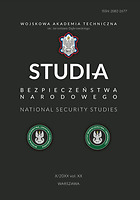TRANSFORMACJA STRUKTUR DOWODZENIA NATO PO 2014 ROKU
NATO COMMAND STRUCTURE TRANSFORMATION AFTER 2014
Author(s): Piotr LenartowiczSubject(s): Security and defense, Geopolitics
Published by: Wojskowa Akademia Techniczna im. Jarosława Dąbrowskiego
Keywords: NATO command structure; elements of the force structure; security; NATO summits; threats;
Summary/Abstract: The aim of the research, the results of which are presented in this article, was to describe the activities undertaken by the North Atlantic Alliance in terms of changes in its command structure after 2014. It explained that the real threats generated by the Russian Federation made it necessary to change NATO’s military structure. The North Atlantic Alliance, taking steps to ensure the security of its members throughout the treaty area, had to adapt its command structure and force structure to the existing real threats, changing its current expeditionary character to be adequate to the anticipated activities. NATO, redirecting its efforts from expeditionary activities to collective defense, had to adapt its command structures regionally and make institutional adaptation. Changes in the alliance’s command structures were forced by the need to implement security measures for the allies from Central and Eastern Europe. Following the decisions of the NATO summits from Newport to Madrid, the alliance successively, adequately to the escalation of threats, reformed and generated forces and resources allocated to the defense of the treaty area, which in turn resulted in the creation of new elements of the command structure and reorientation of the activities of the existing ones. The Alliance has thus embarked on long-term deterrence and defensive adaptation. According to the defined needs, two operational-level commands were created within the NCS, adapting to collective defense. The creation of a multinational corps headquarters, four multinational division headquarters, a multinational brigade headquarters and eight NATO integration units fundamentally changed the alliance’s command architecture by strengthening the structure of the NFS. This made it possible to effectively command NATO forces and resources in the areas of responsibility of the elements created on the eastern flank of the alliance in times of peace, crisis and war. The essence of the actions taken is their flexibility and evolutionary nature resulting from the need for a permanent review of the existing structures and their adaptation to the identified changes in the security environment. The results of the research are of significant value, as they confirm Alliance’s flexibility as well as adaptability to the changing security environment. The results indicate explicitly that the process of NATO’s command & control structure transformation was carried out in a manner which allowed for complementing it with entities as deemed necessary for the identified gapped areas, thus assuring that the ultimate construct will guarantee efficacy of the command. With this regard the Alliance retains its evolutive nature at the same time manifesting the aspiration for ensuring an adequate approach combined with adaptability to the constantly changing security environment.
Journal: Studia Bezpieczeństwa Narodowego
- Issue Year: 25/2022
- Issue No: 3
- Page Range: 89-100
- Page Count: 12
- Language: Polish

